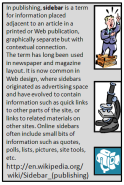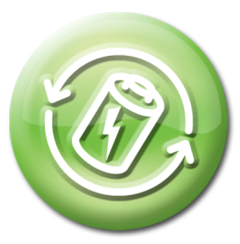

Battery Life
As indicated in the main notes, leaving a laptop plugged in is somewhat controversial. Removing the battery, after a full charge, resolves the problem. My own strategy has been to not worry about the battery until it needs replacement. I then keep the old battery in my docked laptop and use the new one onlt when travelling.
But, what about your cell phone?
Hand-Held Device Batteries
Most hand-held devices are using lithium-ion batteries. (You should check your device.) So, everything said earlier still applies. But how can you optimize battery usage during a cycle?
Android (and others)
Android provides a built-in screen that will report on battery usage (Settings > About phone > Battery). Most people believe that leaving apps running is the problem. It's not so simple. Look at the major users of battery life on your phone and decide what you can do to minimize it, especially the big users.
- Display screen
- The display screen is often the biggest user of power. This is no more than the light used to make the screen visible, and it is adjustable. Most phones have an automatic setting, which I recommend. You can also lower the light level manually to whatever works for you. (Probably making the device fairly useless in bright sunlight. But, when you're outdoors is a good time to try speech recognition).
Sleep mode is intended to save on battery life. When not in actual use, the screen blanks out, although all of the application continue to run. Shortening the amount of time before the light goes off will save power. (Of course, if you lock the device – highly recommended for privacy and to prevent ID theft – you have to unlock the screen before using it again.) In my opinion, screensavers are a waste of power.
- The OS, System & Idle
- Like any computer, the OS and system programs are expected to run continuously. There is nothing much you can do about these. If they are high on your list of power consumers, you're not using your phone for much anyway. The same is true for phone idle.
- Applications
- Lots of apps you have installed want to keep running, so they can start quicker and provide you with timely updates. (These are like all those programs running on your PC that show up in the system tray.) You should consider uninstalling any apps that you don't use often, but the actual CPU usage is not the big problem. Rather, it is the communication many of these apps perform when syncing with your email, Twitter, Facebook, or whatever accounts. Some use GPS to locate you, so they can easily tell you about local restaurants, etc. (Of course, the app can also track you — remember those apps are often third party apps with their own privacy policy.)
Assuming you want to keep using these, you can almost always set how often the app syncs. While phone calls and texts (SMS) should show up immediately, consider whether you can wait longer for email, Twitter and Facebook updates. Set them to sync every 10 minutes instead of every five, and you will cut down on power usage.
The Android has a "app killer" app that lets you specify which apps you want to leave running. Then, with one touch on the widget, you can stop all other apps. Remember to do this when putting the phone away for a while and save even more power.
- Radio
- Generally, you want to leave radio on (assuming you are not flying). This is both your telephone and 3G connection on a smartphone. If you are somewhere where there is no service, you can turn radio off to keep the phone from constantly searching for a connection.
- GPS
- Generally, you can turn GPS off without affecting emergency location service. Assuming you allow it, the phone can still use nearby wireless and/or cell towers to provide an approximation of your location. Indoors, in mountains, or under constant cloud cover GPS can use a substantial amount of power. Turn it off unless you need the location services. (You can always turn it on when you need directions to the nearest Starbucks.)
- Bluetooth
- Bluetooth is great for hands-free phone use, but simply wastes power when not in use. For many of us, it is never used. Also, if not configured properly, others can connect to your phone. Turn on encryption and use bluetooth when you need it.
- Wi-Fi or Wireless
- Connecting to a hotspot or wireless network at home can save on your data usage and allow you to make calls over the Internet (e.g., Skype). Assuming a good broadband connection, it may also be faster. When you leave home (the hotspot) your phone will continue scanning for nearby networks to connect to. This is generally a waste of power. Turn it off when you leave.
The Android provides a widget to allow you to easily turn on/off radio, GPS, Bluetooth and wireless.
Other Devices
Like most Apple products, a goal is to make iPhone use and management as simple as possible. There are tools to assist in battery management and that is the place to start. As to what kinds of things you should be concerned about... all of the items discussed for the Android apply. This is true, in a general sense, for any other device.
Calibration
Calibration is not an issue of battery life overall, or even during a cycle. However, software that reports on remaining battery life tends to get "confused" over time. Occasionally (perhaps once a month), completing a full discharge-charge cycle takes care of this problem. The rest of the time you want to "top off" your charge whenever it is convenient. (Lithium-ion batteries do not have the "memory" problem associated with older batteries.)

This work is licensed under a
Creative Commons Attribution-ShareAlike 3.0 Unported License.
Attribution: Dr. Paul Mullins, Slippery Rock University
These notes began life as the Wikiversity
course Introduction to Computers.
The course draws extensively from and uses links to Wikipedia.
A large number of video links are provided to labrats.tv. (I hope you like cats. And food demos.)


